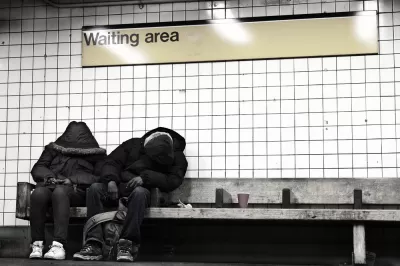Downzoning and building height restrictions have kept supply well behind demand in New York City, according to this article.

"There are currently about 59,000 New Yorkers staying in homeless shelters and several thousand more sleeping on the streets, figures that fluctuate seasonally," Ben Adler writes for City and State New York. Others would rent but are forced to stay with friends and family because they cannot afford the city's high rates. "Add it all up, and New York City’s homeless rate is the highest it has been since the Great Depression, even as the national economy verges on full employment," Adler writes.
Rents have risen twice as fast as wages in the city since the recession. And competition is fierce at the low end of the rent scale. Besides the problem of scarcity driving the prices of affordable homes, there's simply not enough cheaper housing for all the people who would rent it. "The major increase in homelessness is among people who simply lack a place to live and wind up in a homeless shelter. In May, there were 15,023 families, with 22,538 children, sleeping each night in New York City’s municipal shelters, according to the Coalition for the Homeless," Adler reports.
While New York Mayor Bill de Blasio has done some work to allow for more homes near transit, Midtown New York has imposed new height restrictions. Adler argues that this process of treading water on housing production is exacerbating the New York's homelessness issue.
FULL STORY: Homelessness is a housing problem

Alabama: Trump Terminates Settlements for Black Communities Harmed By Raw Sewage
Trump deemed the landmark civil rights agreement “illegal DEI and environmental justice policy.”

Planetizen Federal Action Tracker
A weekly monitor of how Trump’s orders and actions are impacting planners and planning in America.

The 120 Year Old Tiny Home Villages That Sheltered San Francisco’s Earthquake Refugees
More than a century ago, San Francisco mobilized to house thousands of residents displaced by the 1906 earthquake. Could their strategy offer a model for the present?

In Both Crashes and Crime, Public Transportation is Far Safer than Driving
Contrary to popular assumptions, public transportation has far lower crash and crime rates than automobile travel. For safer communities, improve and encourage transit travel.

Report: Zoning Reforms Should Complement Nashville’s Ambitious Transit Plan
Without reform, restrictive zoning codes will limit the impact of the city’s planned transit expansion and could exclude some of the residents who depend on transit the most.

Judge Orders Release of Frozen IRA, IIJA Funding
The decision is a victory for environmental groups who charged that freezing funds for critical infrastructure and disaster response programs caused “real and irreparable harm” to communities.
Urban Design for Planners 1: Software Tools
This six-course series explores essential urban design concepts using open source software and equips planners with the tools they need to participate fully in the urban design process.
Planning for Universal Design
Learn the tools for implementing Universal Design in planning regulations.
Clanton & Associates, Inc.
Jessamine County Fiscal Court
Institute for Housing and Urban Development Studies (IHS)
City of Grandview
Harvard GSD Executive Education
Toledo-Lucas County Plan Commissions
Salt Lake City
NYU Wagner Graduate School of Public Service





























